- 1Poznan University of Life Sciences, Doctoral School, Poznan, Poland
- 2Poznan University of Life Sciences, Faculty of Economics, Economics and Finance, Poznan, Poland
This study examines indices of sustainable rural development in Bulgaria, Germany, Poland, Romania and the Netherlands. The European Union has consistently supported its policy on sustainable rural development and allocated budgetary funds to provide financial assistance. The energy crisis that followed the outbreak of the Russia–Ukraine conflict prompted the European Union to adopt stricter measures regarding sustainable development and energy. To achieve these objectives, it is crucial to accurately identify regional issues and ensure that the established goals are practical and achievable. Some European Union countries have made significant progress in this direction, while others have yet to do so. Therefore, this study is aimed to examine the differences and difficulties of rural development in selected countries of the European Union through data and literature review methods. In the study, the data on population, GDP per capita, greenhouse gas (GHG) emissions, the economic impact of agriculture, and renewable energy are compared for the countries selected at the rural areas and the data on employment, poverty levels, education and rural digitization are compared. Netherlands and Germany exhibit adherence to the goals of sustainable rural development, while Poland has made progress in several areas towards sustainable rural development. In contrast, according to the study, Bulgaria and Romania require more significant measures to achieve sustainable rural development. Although both countries have some strengths, it is imperative that all relevant parties participate in the process to ensure sustainability. Education is a crucial prerequisite for rural development. However, the percentage of educated individuals in these countries has decreased. Furthermore, it is crucial to provide rural areas with information about digitization and establish the required infrastructure. Moreover, the adoption of smart villages should be considered as a solution, in which all stakeholders can efficiently benefit from education and digitization, and sustainable resources can be developed.
1 Introduction
Due to global developments, particularly since the 1970s and 1980s, socio-economic and environmental issues have surfaced and now threaten human life. Subsequently, sustainable development has attained widespread consideration as a means to counteract their adverse impacts on human wellbeing. In light of these impacts, sustainable rural development plays a crucial role in current and developing nations’ welfare standings. In the process of economic development, one can see that rural development impacts every sector of countries by providing resources. However, in certain countries, rural areas still trail behind sectors like industry, transport and construction. Rural development is affected in all aspects, including economic and environmental, by the low energy efficiency and low share of energy consumption in rural areas. For this reason, sustainable rural development that is equitable, competitive, inclusive and environmentally conscious is of significant socio-economic importance.
Rural areas are defined differently by researchers, policymakers, and institutions according to some of their economic, social, and geographic characteristics. The existence of more than one definition of rural and urban areas has shown that these are actually multidimensional concepts. According to the OECD (1994), a rural area is defined as a community with a population density of less than 150 individuals per km2. Furthermore, rural areas are defined by the US Department of Agriculture’s Economic Research Service (2019) as regions with fewer than 2,500 residents and a population density of less than 500 individuals per square mile. The term “rural areas” as defined by Eurostat (2016) for the context of this study, in which at least 50% of the population lives in rural grid cells. Additionally, all areas outside of urban clusters are categorized as “rural areas.“. ‘Urban clusters’ refer to groups of adjacent grid cells, covering an area of 1 km2, that contain no less than 300 individuals per km2 and a minimum population of 5,000.
In many countries, investments are being made in efficient practices and technologies for sustainable development and sustainable energy use in rural areas. The European Commission, through the publication of the European Green Deal in 2019, declared its goal of achieving robust and inclusive sustainable development to fight against climate change. Similarly, the Paris Agreement, signed in 2015, aims to enhance the implementation of the UNFCCC (United Nations Framework Convention on Climate Change) within the framework of sustainable development and poverty reduction. The main objective of the agreement is to increase worldwide efforts to limit the global average temperature rise to 2 °C below pre-industrial levels or below 1.5 °C. Additionally, it aims to adapt to the adverse effects of climate change and increase resilience to it, and to ensure the development of low greenhouse gas (GHG) emissions without undermining food production that does not undermine food production.
Agricultural production plays a vital role in the economies of developed countries’ rural areas. The income generated from the agricultural sector is typically invested in trade and ultimately in the industrial sector, which serves as a source of capital for industrialization. Nowadays, almost every country is faced with the challenge of global warming. In addition, countries have started to increase the use of renewable energy resources in order to reduce energy deficits, solve environmental problems and ensure sustainable development. Thus, it is necessary to analyse rural development and the shift towards sustainable energy, its future prospects in rural regions and its potential effect on energy supply and independence.
When examining the literature on rural development, academic studies are conducted on topics such as socio-economic development, rural poverty, rural migration and income opportunities, however, these studies are limited in number in the literature. The objective of this study is to compare and interpret the state of rural development in high-income and low-income country groups in the European Union (EU). Additionally, it aims to evaluate the state of rural development in low-income countries and provide solutions to improve the situation. The study is focused on sustainable rural development with a comparison of selected EU countries including Bulgaria, Germany, Poland, Romania and the Netherlands. It evaluates and compares the positive and negative aspects of each country’s approach to sustainable rural development. Identified deficiencies of the countries will be presented along with proposed solutions.
2 Materials and methods
In this study, the reports of the EU institutions and statistical data are analysed using the literature and data review method. In addition, policy guidelines and EU legal acquis from available sources in the field of sustainable rural development will be analysed in the study. The questions that are planned to be answered according to the purpose of the article are as follows:
• What are the socio-economic determinants of rural development in Bulgaria, Germany, Poland, Romania and the Netherlands?
• What are the differences in rural development among Bulgaria, Germany, Poland, Romania and the Netherlands?
• What is the economic role of agriculture in Bulgaria, Germany, Poland, Romania and the Netherlands?
• What is the share of renewable energy in agriculture in Bulgaria, Germany, Poland, Romania and the Netherlands?
The main data sources used to answer the above questions are statistical data from Eurostat, the European Commission and Our World in Data. It is intended to explain the sustainable rural development policies in the EU countries, the socio-economic determinants in the rural areas of the selected countries, the economic impact of agriculture, the renewable energy in rural areas and the differences in rural development. The data used in the study are the latest available at the time of writing.
3 Sustainable rural development policies in European Union countries
As restructuring processes have been taking place in many areas of the world for a number of years, several changes have taken place in rural areas. With these changes, development policies in rural areas have also changed and started a new structuring process. The increase in migration from rural areas, poverty, the rapid depletion of natural resources and the associated economic problems have made it necessary to differentiate policies for rural areas. In addition, the fact that the concept of sustainable development has become more important for countries and is mandatory for the future has led to the evolution of rural policies.
There are many definitions of sustainable development in the literature, but the commonly used definition was identified and explained in the report ‘Our Common Future’ published by the World Commission on Environment and Development in 1987. This report, which established a globally important framework for sustainable development, defines sustainable development as ‘meeting the needs of the present without compromising the ability of future generations to meet their own needs’ (WCED, 1987).
The importance of rural areas for sustainable development in environmental, social and economic terms has been increasing day by day. According to Eurostat (2021), 25.2% of the population in the European Union resides in rural areas. But most rural areas in the EU are less favoured for educational, environmental, economic and socio-economic reasons, and some regions are even the least favoured. The population of rural areas has been declining in many countries of the EU (Our World Data, 2023) and this is a threat for the future. However, GDP per capita in rural areas is also well below the EU average (Eurostat, 2023). For this reason, a number of priorities have been identified to ensure the development of rural areas in the EU and to increase employment and living standards in them. In this context, the European Union has set three overarching objectives to be implemented in rural projects: environmental sustainability; social sustainability; and economic sustainability (European Commission, 2023b).
The European Commission has planned to increase the vitality and economic strength of rural areas by developing a Common Agricultural Policy (CAP) for agriculture and rural development. The ultimate aim of CAP is therefore to strengthen the social, environmental and economic sustainability of rural areas and to increase income support for all stakeholders. The CAP’s main objectives for the future can be summarised as follows (European Commission: 2022):
• Competitive incentives in agriculture and forestry
• Sustainable management of natural resources and climate change
• Creation of employment in rural areas and balanced development involving all stakeholders
The Paris Agreement, signed in 2015 by 195 countries under the United Nations Framework Convention on Climate Change (UNFCCC), is an agreement that will affect local, national and regional economies. After the Kyoto Protocol, which was signed in 1997, the Paris Agreement is a vital agreement for the future of the whole world, and in particular for the United States, China and European countries, which have the largest environmental impact. The main goals of the agreement are to prevent the climate crisis and to end the effects of climate change on the world. In this context, the main goals of the Paris Agreement are as follows (UNFCCC, 2015):
• The agreement has a goal of zero carbon emissions after 2050, primarily for developed countries.
• The long-term goal of the agreement is to strengthen global efforts to limit the global average temperature increase to 2 °C above pre-industrial levels and to keep it below 1.5°C.
• For developing countries, the agreement is intended to achieve low-carbon development compatible with climate change.
In the European Green Deal, published in 2019, the European Commission set out a road map to tackle climate and environmental challenges and create a fair, inclusive and sustainable economy for humanity. One of the most important goals set by the EU in this agreement is to create an economy with zero GHG emissions by 2050. By focusing on this goal, the EU has also planned to create a competitive, fair and prosperous society where resources are used efficiently and economic growth is generated from efficient and environmentally friendly resources. In this context, the European Commission has made it a priority of the EU’s climate, energy, transport and taxation policies to reduce net GHG emissions by at least 55% by 2030 compared to 1990 levels (European Commission, 2019).
The European Union has provided financial support by allocating a significant budget to achieve its environmental goals. In the EU’s long-term budget for 2021–2027 and the NextGenerationEU plan, which was published in 2021, the European Commission announced that it would designate about a third of the total budget of 1.8 trillion euros to achieve the goals of the European Green Deal. In this budget, it has planned to finance five different funds for rural development under the heading of natural resources and environment. The first of these funds, the European Agricultural Guarantee Fund (EAGF), is expected to provide financial support to farmers and rural stakeholders for issues such as public intervention purchases, special storage aid and sector-specific exceptional support measures to assist and stabilize agricultural markets. The European Commission has earmarked 291.09 billion euros for the EAGF to be paid to member states. The European Agricultural Fund for Rural Development (EAFRD), which is expected to receive 95.51 billion euros, is another important fund that supports the transition to fully sustainable agriculture. In addition, the European Commission has planned to spend 6.11 billion euros on the European Maritime, Fisheries and Aquaculture Fund for the efficient and sustainable use and management of marine resources. This fund, which is important for the protection of marine biodiversity, is intended to provide resources for sustainable fisheries and aims to provide consumers with high-quality and healthy seafood. Another important fund, the Environment and Climate Action Programme (LIFE), which includes four sub-programmes on nature and biodiversity, circular economy and quality of life, climate change mitigation and adaptation, and clean energy transition, is planned to finance 5.43 billion euros. The main objective of this programme is to ensure the transition to a sustainable, renewable energy-based, circular and energy-efficient economy. Combating biodiversity loss and ecosystem degradation is also a major focus of this comprehensive programme. The Just Transition Fund, which is expected to cost 19.32 billion euros, will target the regions most affected socio-economically by the climate transition. The aim is to increase economic diversification, create new businesses and support clean energy projects in these priority regions. For this reason, efficient and productive investments in these small and medium-sized enterprises will be supported and resources financed. On the other hand, it is expected that workers will be trained, retrained and helped to find jobs in order to generate employment in these regions. These funds, which are very important for the future of rural development, are intended to encourage rural areas to create opportunities in the circular and bioeconomy. It is expected that the European Commission will attach importance to the development of rural areas and the transition to clean energy, especially with regard to important issues such as climate change, renewable energy sources and biodiversity.
The EU is considered a region with high external energy dependence, especially on Russia. The fact that about 65% of natural gas imports come from the Russian Federation shows that the European Union has serious energy security challenges in the future as a result of the war in Ukraine. The European Commission presented the REPowerEU plan in 2022 to tackle some of the challenges arising from the Ukraine war and disruptions in the global energy market. The key objectives of the REPowerEU plan were identified as energy savings, diversification of energy supply and clean energy generation. In this context, the REPowerEU plan aims to make Europe independent from Russian fossil fuels before 2030 by providing the necessary financial support and legal measures to build the new energy infrastructure that Europe needs. The plan has taken into account many measures to support rural development and make it sustainable. REPowerEU, which is particularly important for the energy transition in rural areas, has planned the development of small biogas plants operating in the European Union as a solution to the energy problems in rural areas. In addition, the strategy has envisaged using existing local infrastructure for the harmonious implementation of the European Commission’s Common Agricultural Policy Rural Development Funds and for the development and implementation of the farmers’ cooperative structure. It is intended that these developed strategies will cover all stakeholders in rural areas and further develop urban–rural links. In the plan, it is expected that energy stakeholders in rural areas will come together and implement efficient and inclusive projects through the Rural Energy Community Advisory Hub.
4 Socio-economic determinants in rural areas of selected European Union countries
The socio-economic determinants and priorities in rural areas of Eastern European countries, Western European countries and Nordic countries have been different from each other and this is reflected in their future plans and policies in rural areas. Therefore, socio-economic indicators are quite relevant for sustainable rural development.
4.1 The population and employment of rural areas
Population in rural areas, which is a critical indicator for sustainable rural development, is considered vital for the future of the world, especially in the long-term population projections. The population in rural areas has seriously decreased and there has been migration1 from rural areas to urban areas. Figure 1 shows the rural population since 1950 for Germany, the Netherlands, Poland, Bulgaria, Romania and Europe. After 2022, the figure shows the projected numbers for the long-term forecast up to 2050. The figure indicates that the rural population will continue to decline in almost all countries. Germany kept its population somewhat more stable until the 2000s, but after the 2000s it started to decline. On the other hand, Poland is one of the countries that has maintained its rural population until recently, but its rural population is expected to decline after 2025. In the Netherlands, which is one of the most developed agricultural countries in the world, technological development in agriculture may have an impact on the rural population, but its rural population has been declining rapidly since the 1990s. Moreover, the share of the rural population in the total population in 1990 was 26.8% in Germany, 43.87% in the Netherlands, 38.7% in Poland, 46.7% in Romania and 33% in Bulgaria. In 2022, this share decreased to 22.3% in Germany, 7.1% in the Netherlands, 45.5% in Romania and 23.6% in Bulgaria. In contrast to these countries, the share in Poland increased to 39.8% in 2022. In 2050, the share of the rural population in the total population is estimated to decrease to 15.6% in Germany, 3.37% in the Netherlands, 29.6% in Poland, 33.3% in Romania and 15% in Bulgaria. According to the figure, if we consider that in 1950, 100 people lived in rural areas in European countries, it is estimated that this number will be 44 people in 2050. It is also expected that this number will be 55 people in Germany, 13 in the Netherlands, 62 in Poland, 45 in Romania and 15 in Bulgaria.
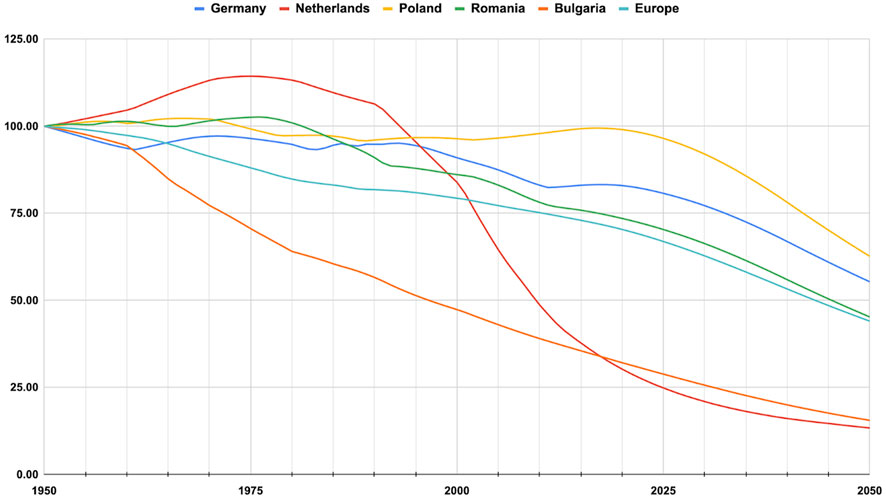
FIGURE 1. Population of rural areas 1950–2050 (1950 = 100). Source: Our World in Data (2023).
For the sustainable development of rural areas in the EU, preventing rural–urban migration and protecting the population2 is one of the most important issues. The decline of population in rural areas has a negative impact on agricultural activities, employment and sustainable development. One of the main reasons for rural depopulation and changing population distribution is that, in many countries, urbanized regions offer a high level of development while, rural areas lag behind in some respects. In Bulgaria, Romania and Poland, the lack of employment opportunities in rural areas is one of the main reasons for migration to urban areas. In rural areas of Bulgaria and Romania, there are infrastructure deficits in areas such as energy, transport and communication, which can have a negative impact on the quality of life. Meanwhile, individuals residing in rural regions of Bulgaria and Romania have relocated to urban areas with the aim of enhancing their standard of living (Jończy et al., 2021; Petrov, 2021; GUS, 2022; European Commission, 2023a). The situation in Germany and the Netherlands is somewhat different. The demographic changes associated with the decline in fertility rates and the increase in the elderly population in Germany have led to a decline in the rural population. In Germany, there is migration from rural areas to urban areas due to job opportunities, although less than in other countries. Compared to other countries, this situation causes less migration in the Netherlands. However, one of the most striking reasons for migration in the Netherlands is the widespread use of technology in agriculture. While this situation has led to an increase in large farms and a decrease in small farms, it has also increased migration to urban areas (European Commission, 2020; Ernst et al., 2023). In selected countries, rural depopulation can often lead to an older age structure and a higher proportion of people with low levels of education in rural areas. In addition to immigration, however, employment rates should also be taken into account.
Along with population, the employment rate is one of the most important socio-economic indicators in rural areas. The decline of the rural population and migration to urban areas make it more difficult to find people to work in rural areas. While the employment rate in rural areas between the ages of 20 and 64 in the EU was 67.5% in 2012, this rate has increased to 74.8% in 2022. However, although the rate appears to have increased, the number of people in employment has not, indicating that the reason for the increase in the employment rate is due to population decline. Figure 2 shows the employment rates in cities, towns, suburbs and rural areas for Germany, the Netherlands, Poland, Bulgaria, Romania and Europe between 2012 and 2022. In the EU, employment rates have increased for each degree of urbanization in 2012 and 2022. Between 2012 and 2022, the employment rate in the European Union3 is estimated to have increased by 7.3 percentage points in rural areas, 7.6 percentage points in cities, and 6.1 percentage points in towns and suburbs. While employment rates in Bulgaria, Germany, the Netherlands and Poland increased at each level of urbanization, this did not occur in Romania. Romania’s employment rate in rural areas fell from 66.7% in 2012 to 60.9% in 2022. Similarly, the employment rate in Romania’s towns and suburbs declined from 67.1% in 2012 to 61.5% in 2022. In contrast, the employment rate in cities in Romania increased from 64.8% to 78.2% between 2012 and 2022. One of the main reasons for this is a change in methodology in Romania in 2021. In Romania, those who produce agricultural products for their own consumption were excluded from employment. This, along with rural–urban migration and other important reasons, accounts for the significant decline seen here. In addition, the coronavirus pandemic that started in late 2019 also had a negative impact on rural employment. The rural employment rate in Bulgaria, which was 66.1% in 2019, fell to 64.2% in 2021. In Germany, this effect was different. The rural employment rate in Germany, which was 83.6% in 2019, dropped to 82.1% in 2020 and then returned to its pre-coronavirus pandemic level of 83.3% in 2021. The rural employment rate in the Netherlands was not much affected by the coronavirus pandemic, and the employment rate in rural areas is almost the same between 2019 and 2020, at 83.4% and 83.3%. The rural employment rate in the Netherlands have increased to 84.6% in 2021, but remained the same in 2022. In Poland, the rural employment rate was also unaffected by the coronavirus pandemic, at 70.7% in 2019, 71.3% in 2020, and 72.7% in 2021. Romania’s rural employment rate was 69.4% in 2019 and declined to 68.7% in 2020.
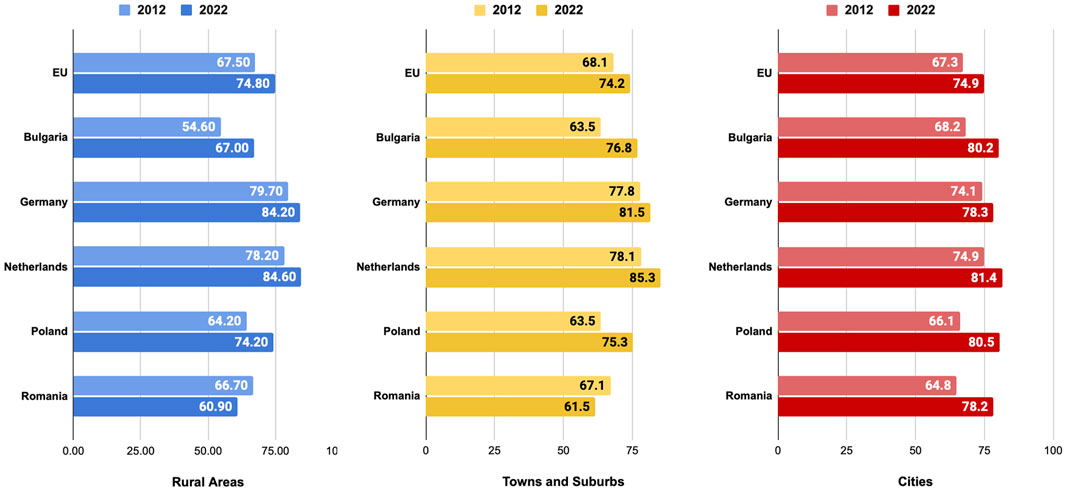
FIGURE 2. Employment rate (20–64 years) by degree of urbanization, 2012 and 2022 (%). Source: Eurostat (2023).
Particularly in recent years, rural youth have taken longer to settle in the labour market. At the same time, the fact that young people change jobs more often and migrate from rural to urban areas is another important issue in rural employment. For this reason, one of the indicators that can be considered together with rural employment and population is the not in education, employment or training (NEET) rate for the 15–29 age group. According to Eurostat data for 2022, the NEET rate for young people aged 15–29 is, on average, 12.6% in the European Union, 6.2% in Germany, 3.3% in the Netherlands and 12.5% in Poland. The situation is worse in Romania and Bulgaria with NEET rates of 27% and 23.8%, respectively. Romania has the worst rural NEET rate in the European Union.
4.2 GDP per capita and poverty in rural areas
The structural changes that have taken place in the European Union and around the world since industrialization have accelerated economic development and raised living standards. Although the average per capita income in the EU has increased significantly, the average income in rural areas is still lower than the that in urban areas. In addition, people living in urban areas have better employment opportunities. This condition is seen to be less prevalent in the western countries of the EU than in the eastern countries.
In the EU, the average gross domestic product (GDP) per capita in rural areas is lower than in urban areas. Although there are many reasons for this, the most important may be differences in employment opportunities, education, and economic and commercial activities. According to the data calculated by Eurostat, the GDP per capita adjusted for purchasing power in rural areas in the EU was 15,500 euros in 2005, but this figure increased to 23,200 euros in 2020, an increase of approximately 50%. However, if we take the same years as a basis, the GDP per capita adjusted for purchasing power in urban areas of the EU this was 28,300 euros in 2005 and increased to an average of 37,000 euros in 2020. The increase in that period is 30%. Although the gap in purchasing power adjusted GDP per capita between rural and urban areas in the EU has narrowed between 2005 and 2020, the average GDP per capita in rural areas is still significantly lower than in urban areas.
Figure 3 shows the GDP per capita adjusted for purchasing power in rural areas of selected countries in the EU4 between 2000 and 2020. The graph underlined that there is an income gap between Germany, the Netherlands and Poland, Romania and Bulgaria, with Germany and the Netherlands being above the EU income average, while Poland, Romania and Bulgaria are below it. The figure shows that after 2015, Romania has moved a little further away from Bulgaria, increasing its per capita income more and at the same time moving a little closer to Poland. However, the rural income gap between Germany and the Netherlands and the other three countries is also clearly visible on the graph. On the other hand, in terms of convergence, the average income of Germany and the Netherlands was 4.19 times that of Bulgaria, Romania and Poland in 2000, but it decreased to 2.23 times in 2020.
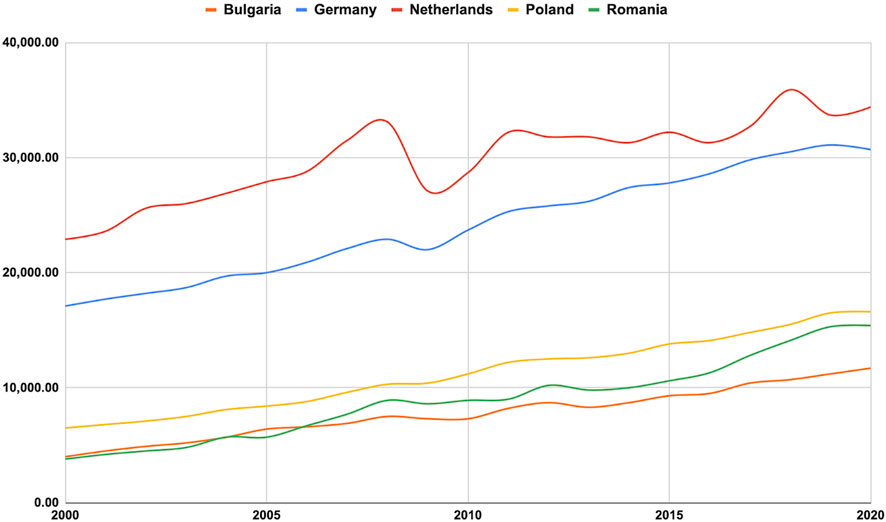
FIGURE 3. Gross domestic product (GDP) per capita adjusted by purchasing power in rural areas. (2000–2020). Source: Eurostat (2023).
The main reasons for low income in rural areas in Romania are considered to be the low income from agriculture and households with more children. The lack of employment opportunities in rural areas, the continuation of subsistence agriculture and the low level of education have led to lower incomes (Popescu, 2022). In Bulgaria, the reasons for low income in rural areas are similar to those in Romania. High unemployment, a decrease in the rural population, the low education and the low quality of labour force and insufficient economic infrastructure are the main factors negatively affecting the income in Bulgarian rural areas (Ivanov and Sokolova, 2017). Moreover, the poverty rate in rural areas, together with the income, is one of the important problems that need to be solved in these countries.
Poverty can be defined in absolute (in terms of enjoying the basic necessities of life) or relative (in terms of other people in society) terms, with absolute poverty being more commonly used in developing countries. Absolute poverty is used to determine the number of people below a fixed poverty line. In the EU, on the other hand, this situation is usually measured in relative terms. Poverty is measured by determining the median household income of people with less than a certain percentage of their income. Accordingly, the poverty rate is measured by the share of the population whose income is less than 60% of the median household income (Augère-Granier, 2017).
Poverty is thought to be one of the factors for the need for socio-economic development in rural areas, especially in Eastern European countries. Figure 4 shows poverty rates by degree of urbanization in selected countries in the EU for 2012 and 2022. The EU averages are examined, and we can see that the poverty rates of rural and urban areas are close to each other. When selected countries are checked, the rural poverty rate of the Netherlands and Germany are below the EU average, the rural poverty rate of Romania and Bulgaria is above it, and the rural poverty rate of Poland is almost equal to the EU average. In urban areas, between 2012 and 2022, the developed countries Germany and the Netherlands failed to reduce their poverty rate. In rural areas, Germany reduced its poverty rate to 16.7% between 2012 and 2022, while, by contrast, the poverty rate in the Netherlands rose to 12.4% during that time, but still the Netherlands has the third best rate5 in the EU. Poland had a 32.7% poverty rate in rural areas in 2012, which has dropped in 2022, to 22.7 percent, but is still at the same level as the EU average. In Bulgaria and Romania,6 the poverty rates in rural areas are the worst rates in the EU. The rural poverty rate in Bulgaria was 61.4% in 2012 and has dropped drastically to 40.5% in 2022, but has remained the second highest rate in the EU. Romania, on the other hand, has the highest poverty rate in the EU at 45.6% and was able to reduce it by only 2.4 percent between 2012 and 2022. Rural poverty rates have also been affected by the coronavirus pandemic and vary between selected countries. The rural poverty rate in the European Union averaged 22.9% in 2019 and increased to 23.3% in 2020. The rural poverty rate in Bulgaria was 49% in 2019 and 48.8% in 2020, but decreased to 42.5% in 2021. The rural poverty rate in Germany was 15.5% in 2019, but increased to 17.7% in 2020. Similar to Germany, the rural poverty rate in the Netherlands was 10.5% in 2019, 11.8% in 2020 and increased to 13.2% in 2021. During the coronavirus pandemic, the rural poverty rate in Poland changed almost negligibly. The rural poverty rate in Poland was 24% in 2019 and 24.2% in 2020. In Romania, rural poverty also increased very slightly over this period. The rural poverty rate in Romania is 49.2% in 2019 and 50.4% in 2020. Accordingly, the impact of the coronavirus pandemic on rural poverty was slightly higher in Germany and the Netherlands, which are more developed countries than others.
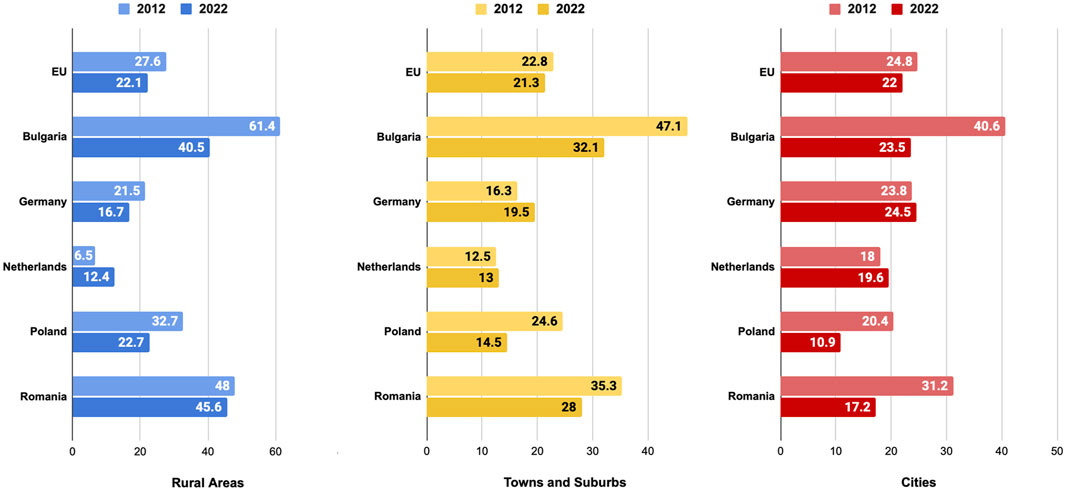
FIGURE 4. Poverty rates by degree of urbanization, 2012 and 2022 (%). Source: Eurostat (2023).
The labour market in rural areas in Poland has some disadvantages, which are directly reflected in the income level of the rural population. Problems such as a low level of education in rural areas and insufficient investment in social and technical infrastructure, which are created within the framework of needs, are directly reflected in poverty. Moreover, poverty in rural areas in Poland is particularly strong in areas where agriculture dominates the economy and there are no non-farm employment opportunities (Żmija, 2013). When looking at rural areas in Poland spatially, there are significant differences in poverty. The fact that families living in rural areas are larger than those living in urban areas, as well as regional unemployment, leads to the persistence of small and low-profit enterprises. This has been one of the major causes of poverty (Z;mija, 2015).
An analysis of poverty rates in the countries of the EU shows that there are geographical differences. It has been observed that in the Eastern, Southern and Baltic countries of the EU, the highest rates of poverty and risk of social exclusion are found among the rural population. Conversely, the risk of poverty and exclusion is considered to be a greater threat in cities in the western and northern countries of the European Union. For these reasons, cities in the eastern part of the EU appear to have lower risks of poverty and social exclusion, while cities in western Europe are more prosperous. This situation can also be seen as an urban paradox (Eurostat, 2018).
4.3 Education in rural areas
Education is considered to be one of the basic elements of sustainable rural development. In rural areas, human resource development and skilled employment in particular depend on education, and this situation affects all areas of sustainable rural development. Issues such as poverty reduction, gender equality, agricultural productivity and rural–urban migration are linked to education. In urban areas, access to education is easier than in rural areas. In some countries of the EU, the level of education is known to be significantly lower in rural areas. This is particularly true in countries such as France, Greece, Ireland and Italy. However, the low quality of personnel in rural areas, the inadequacy of information communication and of vocational training cause the rather low quality of education in rural areas (Augere-Granier, 2017).
Figure 5 shows the share of people aged 15–64 with less than primary, primary and lower secondary education attainment, by degree of urbanization in 2012 and 2022 for selected countries in the EU. According to the figure, the EU average decreased faster in rural areas than in urban areas. The EU average in rural areas was 33.5% in 2012 and decreased to 25.3% in 2022. Although this rate has decreased in rural areas in Bulgaria and Romania, it is still well above the EU average. In 2022, this rate was 33.2% in Bulgaria and 32.9% in Romania. Over the decade period, the Netherlands and Poland managed to reduce this rate, but the situation in Germany seems to be the opposite. There, the rate increased between 2012 and 2022 in both urban and rural areas.
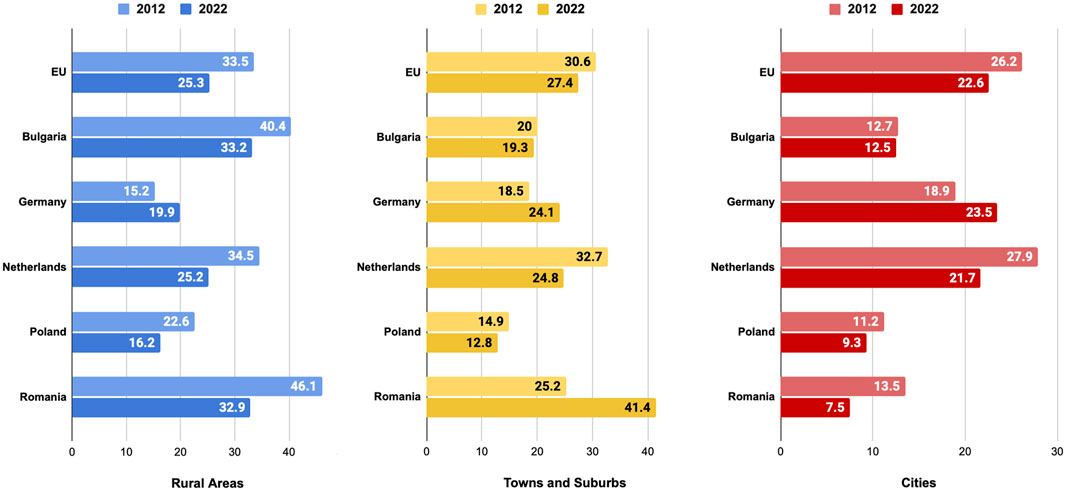
FIGURE 5. Share of people aged 15–64 with less than primary, primary and lower secondary education attainment, by degree of urbanization, 2012 and 2022 (%). Source: Eurostat (2023).
One of the most important components of rural development is the reduction of fossil resources and the transition to sustainable and renewable energy sources. One of the most important factors influencing the energy transition in rural areas is education. Education in energy transition in rural development is very important to achieve goals such as awareness and adaptation to renewable energy sources. In addition, the support of educated individuals in rural areas is needed in terms of active participation in the energy transition process and acting as conscious individuals.
4.4 GHG emissions and environmental impact in rural areas
There are many factors that contribute to GHG emissions in rural areas. Agriculture in rural areas is particularly important in terms of climate change and environmental impact. It is estimated that the relationship is bidirectional. The largest environmental impact of agriculture is the emission of GHGs. According to the research, the GHG emissions emitted by farms correspond to approximately 16%–27% percent of the emissions7 resulting from human action or inaction (IPCC, 2019). Despite improvements in energy efficiency and the use of innovative technologies and renewable energy sources, energy use in rural areas has been one of the largest contributors to GHG emissions. In the EU, energy generated by the use of fossil fuels, particularly in rural areas, has caused carbon emissions. Fuel use in rural regions is used in other areas such as heating and transportation, as well as electricity generation. Emissions from agricultural areas in the EU are estimated to decrease by only 2.3% in 2030 compared to 2005, according to long-term projections. In addition, if the measures to reduce non-CO2 emissions planned by the EU are implemented, a decrease of 6% is expected (EEA, 2022).
Figure 6 shows GHG emissions in agriculture in 1990 and 2021 for selected countries in the EU. When the graph is examined, it is seen that agricultural GHG emissions8 tend to decrease between 1990 and 2021 in the EU. It can be estimated that the decrease is due to the support by the EU countries in the field of renewable energy and the applications made to increase energy efficiency. Developed countries such as Germany and the Netherlands have managed to reduce GHG emissions in the agricultural sector. In particular, after 2016 the decrease in Germany is noticeable. GHG emissions from agriculture in Poland showed a downward trend until the early 2000s, but then showed no serious change until 2021 when it increased slightly. In Romania, GHG emissions from agriculture tended to decrease until the 2010s, after which they show a slight upward trend until 2021. In Bulgaria, agricultural GHG emissions tended to decrease until 1997, but showed no serious change in the following years.
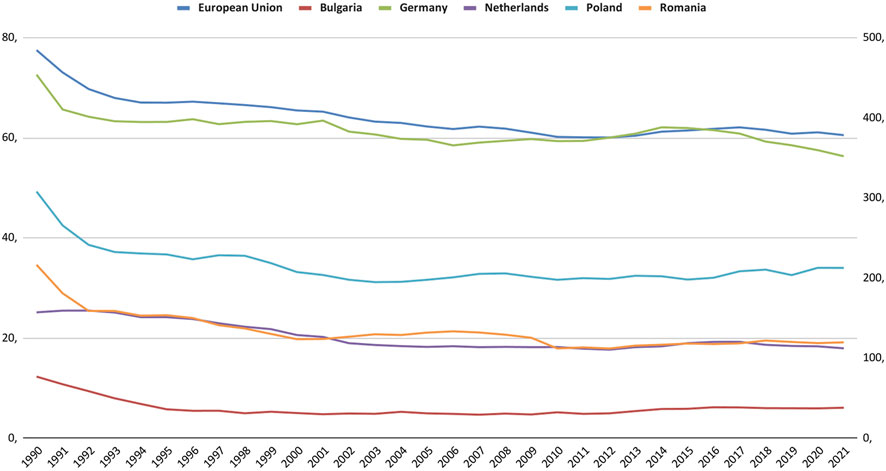
FIGURE 6. GHG emissions in agriculture (Million Tonnes). *The European Union average data are indexed on the right side of the graph and the other countries number indexed on the left side. Source: Eurostat (2023).
In addition to GHG emissions from agriculture, the share of GHG emissions from agriculture in total GHG emissions should also be examined. Figure 7 shows the share of GHG emissions from agriculture in total GHG emissions in 1990 and 2021 for selected countries in the EU. According to the graph, the share of GHGs originating from agriculture in the total GHG emissions in the EU and selected countries is increasing. In 2010, the share of GHGs originating from agriculture in total GHGs was 8.8%, and this rate increased to 10.7% in 2021. It can be seen that although GHG emissions in the EU have decreased, there are some problems with GHG emissions from agricultural areas. In the EU, it can be seen that the reduction of GHG emissions in urban areas is faster than the reduction of GHG emissions in rural areas. During the coronavirus pandemic, the share of GHG emissions from agriculture in the European Union has increased. The share of GHG emissions from agriculture in the European Union was 10.2 percent in 2019 and increased to 11.4 percent in 2020. In 2021, the share of GHG emissions from agriculture decreased to 10.7%.
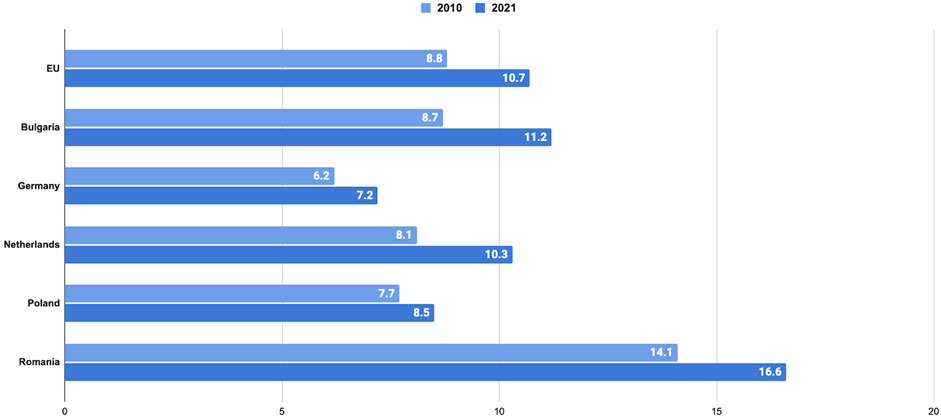
FIGURE 7. The share of GHG emissions from agriculture in total greenhouse gas emissions. Source: Eurostat (2023).
4.5 Digitization in rural areas
The EU attaches importance to green transformation for sustainable development in rural areas, but on the other hand, digitalization and digital transformation are also very important elements. Digitalization not only affects the welfare of society, but also has increased productivity by opening up new ways of access in every field. However, the impact of digitalization is greater in developed countries. This is because less developed countries are still in the process of transition from labour-intensive to capital-intensive technology. In this case, the information technology infrastructure and increasing the digitization skills of the employment should be given importance as a financial support (Maucorps et al., 2023). For this reason, digitization has become one of the most important focal points to support sustainable development, and to increase productivity and competitiveness in rural areas, especially in agriculture, forestry and livestock. Digitization, especially in rural areas, varies regionally, but is not yet developed, and there are quite a few differences and constraints in terms of access to information technologies between some regions.
In the report ‘Europe’s Digital Decade: Digital Targets for 2030′ published in 2022, the European Commission has published a series of targets to be achieved by 2030 for digitization and digital transformation. According to the report, the main issues to be achieved by 2030 are digital skills, digital transformation of enterprises, secure and sustainable digital infrastructures, and digitization of public services. The European Commission aims for at least 80% of the population to have basic digital skills by 2030. By 2030, 75% of businesses in the EU are expected to use cloud/AI/big data. Other key targets are for key health services to be 100% online, for 100% of EU citizens to be able to access their health records online and to have access to a digital identity. The association of digitalization with the concept of smart villages has gained an important dimension, with the inclusion of rural areas in these targets. Therefore, digitalization has played an important role in smart villages to increase their resilience and develop innovative solutions based on rural strengths and opportunities.
Internet access and use in rural areas is one of the important components of sustainable development. The most important reason for this is that Internet use is considered as a factor that affects human life and local development. Figure 8 shows the percentage of Internet use by individuals by urbanization (last Internet use: last 3 months) in 2012 and 2022 for selected countries in the EU. The rate of Internet use in rural areas in the EU was 61.94% in 2012, and this rate increased to 86.38% in 2022. This means that a significant proportion of the population has adopted the use of the Internet. However, on the other hand, Internet use in rural areas is still 5.8 points less than Internet use in cities. The lowest rate of Internet use in rural areas is in Bulgaria with 71%, while the highest rate is in the Netherlands with 94%. Internet use in rural areas in Poland, Romania and Bulgaria is lower than the EU average. In addition, according to Eurostat data, the rate of those who do not use the Internet in rural areas in 2022 is approximately 10% in the EU. In addition, according to Eurostat data, the rate of those who do not use the Internet in rural areas in 2022 is approximately 10% in the EU. This rate is 19.4% in Bulgaria, 6.19% in Germany, 2.5% in the Netherlands and 15.35% in Romania.
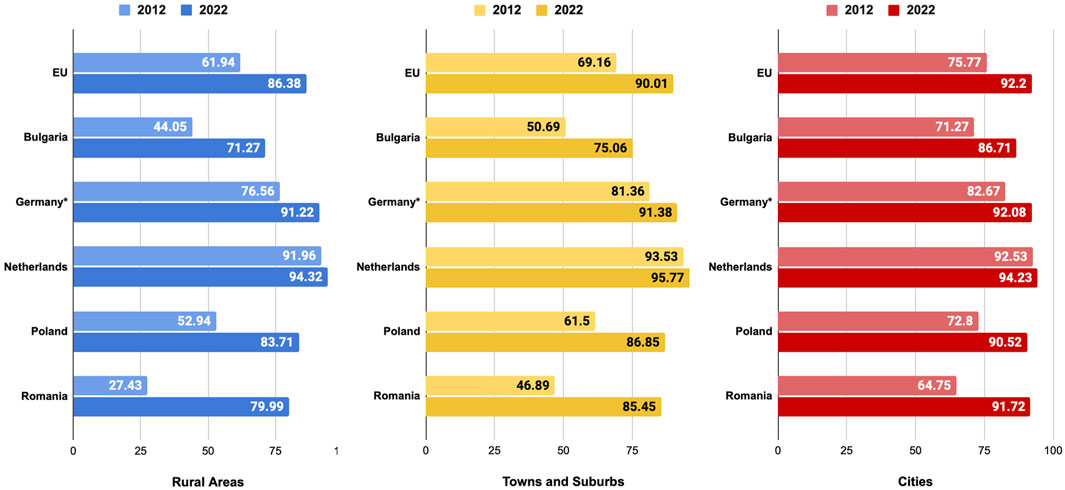
FIGURE 8. Internet use percentage of individuals by urbanization (last internet use: last 3 months). *There is no data for Germany in 2012. For this reason, it was taken from 2011 data. Source: Eurostat (2023).
The European Commission announced a new index for rural areas in 2023. This index, named the ‘Rural Digital Index’, is calculated for the year 2022 in EU countries. The index calculation is based on Internet use, human capital and connectivity in rural areas and a value between 0 and 100 is determined. Figure 9 presents the digital score for rural areas in 2022 for the EU and selected countries. Accordingly, the EU rural digital score average is 44. Poland, Bulgaria and Romania are below the EU average in the rural digital score, and the Netherlands is well above it. Another remarkable situation here is that Germany has the same score as the EU average.
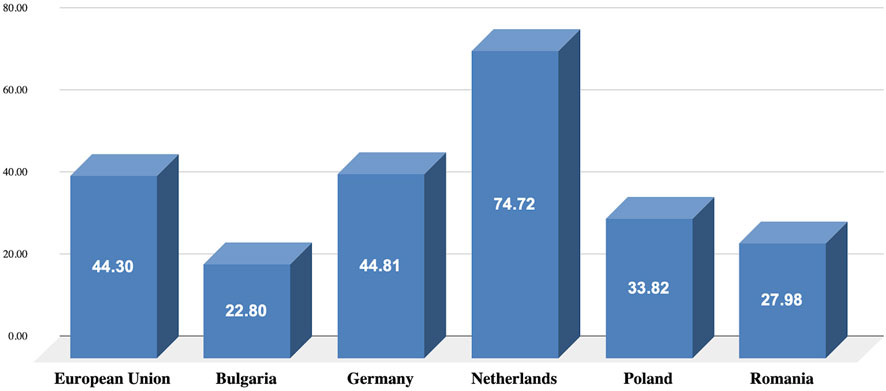
FIGURE 9. Rural digital index (2022). Source: European Commission Digital Agenda (2023).
4.6 Economic impact of rural areas and agriculture
Agriculture in the EU is of great economic importance and the EU has played an important role both in the Union and in the world, especially in agricultural exports. The impact of agriculture, which is one of the basic building blocks of sustainable development in rural areas, on biodiversity, soil and water quality due to climate change is considered to be a major threat for the EU in the future. For this reason, the EU defines its agricultural and rural policies within the framework of sustainable development and climate change.
Rural areas and agriculture have many direct and indirect impacts on the economy. Rural areas have an impact on the economy in numerous areas, such as food and agriculture, livestock, fisheries, forestry, foreign trade, tourism, employment, and the use of alternative energy sources. According to the data published by Eurostat for 2020, the contribution of rural areas from the EU to the economy is 1.8 trillion dollars. In 2020, the share of agriculture, forestry and fishing in the total GDP in the EU was 1.6%.
Figure 10 shows gross value added in rural areas (total NACE9 activities) in 2008 and 2020 for selected countries in the EU. In 2008, the gross value added in rural areas in the EU was approximately 1.5 trillion dollars; in 2020 this number increased to 1.8 trillion dollars. It is understood from this that the economic contribution of rural areas in the EU is quite remarkable. The gross value added of Germany’s rural areas is quite high, at $400 billion in 2020 and in terms of the highest rural area value added in the EU, it is second after France. Bulgaria is one of the countries with the lowest value in the EU, with a gross value added of approximately 5 billion dollars in rural areas in 2020. In 2020, the gross value added of rural areas in Poland is 120 billion dollars, and the gross added value of rural areas in Romania is 74 billion dollars. The low value added of the Netherlands, a country considered developed in terms of rural areas, is due to the size of the country’s rural and urban areas in square kilometres. Specifically, the size of rural areas per square kilometre in the Netherlands is quite small. Furthermore, an analysis of Eurostat data on gross added value per employed person (labour productivity) of rural areas revealed that Bulgaria and Romania have experienced significant growth between 2008 and 2020, with rates of 83.9% and 65.3% respectively. During the same period in Bulgaria, the employment rate for 20–64 years old has increased in rural areas, but the number of employed people has decreased. In Romania, the number of people employed in rural areas has decreased over the same period, however, the employment rate for those aged 20–64 in rural areas has increased. In the same period, Germany recorded a growth of 31.4%, but the Netherlands had a slightly lower growth rate of 8.9%. Poland also accomplished significant growth, with an increase in gross added value per employed person of rural areas of 42.9% between 2010 and 2020. Poland has achieved less growth than Bulgaria and Romania, but a higher percentage of growth than Germany and the Netherlands.
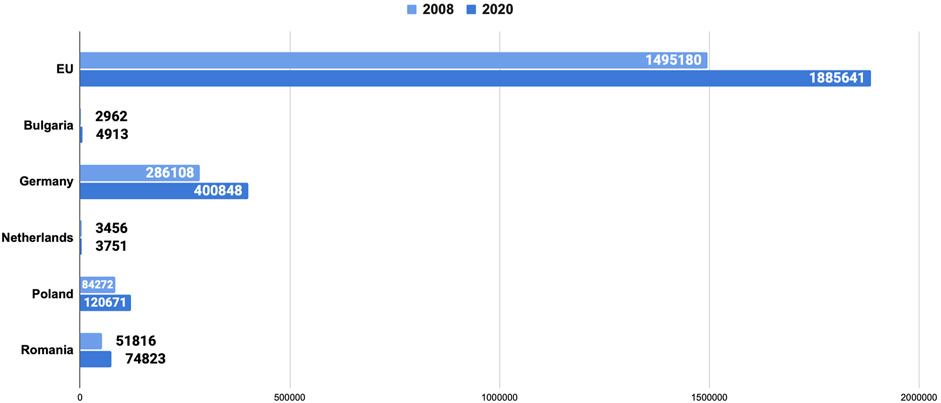
FIGURE 10. Gross value added in predominantly rural areas (million Euro). Source: Eurostat (2023).
Figure 11 shows gross value added in agriculture, forestry and fishing as a percentage of the GDP) between 2000 and 2020 for selected countries in the EU. The share of agriculture, forestry and fishing sectors in the total economic production in the EU was 2.2% in 2000, but decreased to 1.6% in 2020. Population movements from rural areas to urban areas in the EU have an impact on this share. At the same time, the growth of the Union in the industry and service sector also has an impact on this situation. On the other hand, technological developments, which are mostly used in developed countries, have led to less use of employment. The gross value added share of agriculture, forestry and fishing in Germany was 1% in 2000 and 0.8% in 2020. In Poland, this rate was 3.1% in 2000 and decreased to 2.6% in 2020. Compared to other countries, the decline is less in Germany and Poland. The gross value added share of agriculture, forestry and fishing in the Netherlands decreased to 2.3% in 2000 and to 1.6% in 2020. The sharpest declines in this ratio between 2000 and 2020 occurred in Romania and Bulgaria. The gross value added share of agriculture, forestry and fishing in Romania was 10.9% in 2000, and decreased to 4.2% in 2020. In Bulgaria, on the other hand, it was 11% in 2000, but decreased to 3.5% in 2020.
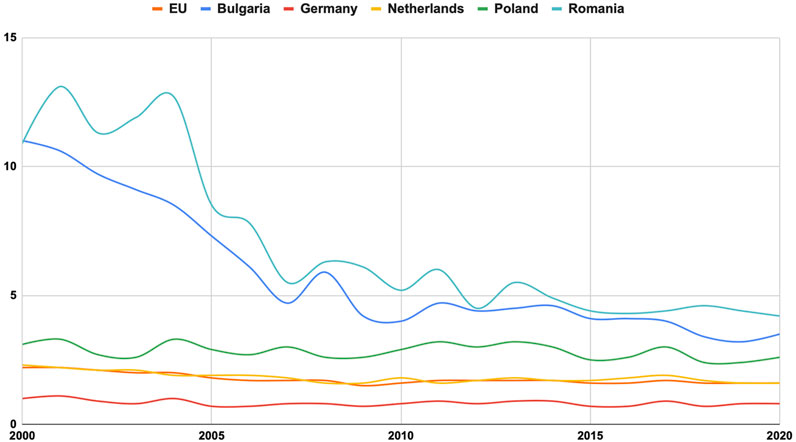
FIGURE 11. Gross value added in agriculture, forestry and fishing (percentage of GDP). Source: Eurostat (2023).
It is believed that one of the most fundamental relationships of production processes in the economy is the input–output relationship. Therefore, studying the total factor productivity in the economy provides important details about the efficiency of long-term production. In addition to the reviewed data for economic impact, the total factor productivity in agriculture has not changed between 2012 and 2022. According to Eurostat data, the average annual change in total factor productivity in agriculture between 2012 and 2022 was 0.8%. Germany and the Netherlands are in a slightly different situation, although there has been some increase in developing countries, and total factor productivity in agriculture in Germany and the Netherlands increased by only 0.1% per year, on average, between 2012 and 2022, which implies almost no change. Over the same period, total factor productivity in agriculture changed by an annual average of 2.3% in Poland, 1.9% in Bulgaria and 1% in Romania. Developing countries in the European Union outperformed developed countries in terms of total factor productivity in agriculture in the base years.
4.7 Renewable energy in rural areas and agriculture
Energy transition and the use of renewable energy is considered one of the most fundamental components of sustainable development. Rural areas with renewable energy sources have supported sustainability by providing energy security, contributing to the regional economy, and producing fewer carbon emissions than fossil fuels. Renewable energy is one of the most important solutions to the problem of energy shortage in rural areas in terms of electricity and heat, as it offers the opportunity to produce their own energy instead of importing it. In rural areas, sustainable and affordable energy production is also a driving force for development. The use of renewable energy in rural areas has also contributed to the creation of many employment opportunities, as many stakeholders come together and integrate into the local economy. The specialization and skill development of these economic actors has led to the strengthening of the capacity of the regional economy and its communities (OECD, 2012).
One of the most important features of renewable energy is that the resources are sustainable and environmentally friendly, but renewable energy also has some risks. For example, biomass production from renewable energy sources can cause deforestation. Destruction and land use change, especially in the last 50 years, is one of the factors causing biodiversity loss. Although technology has reduced the risk, there is a danger that dams built for hydroelectric power will flood the region. This situation can cause much economic, environmental and social destruction in this region. At the same time, the production of wind energy can cause noise pollution. This has revealed a social cost problem in this area (Upreti, 2004; Richter et al., 2010; Wolsink, 2010; Bagher et al., 2015; Costanza et al., 2017; Maradin, 2021).
The EU has set a goal to ensure a sustainable green transition of citizens and businesses and to become the world’s first climate neutral continent by 2050 through the European Green Deal. In particular, due to the negative situation after the outbreak of the Russia–Ukraine war and the global gas price crisis, the EU wants to act more decisively for green technologies. It is planned to increase the share of renewable energy in every sector in the EU each year, and the share of renewable energy in total energy consumption is targeted at 42.5% by 2030. According to Eurostat data in the EU, the share of renewable energy in total energy consumption in 2021 is 21.8%. Sweden had the highest share of renewable energy sources in the EU in 2021, with a share of 62% (IEA, 2022; Cremona, 2023). Figure 12 shows the share of energy from renewable sources in 2008 and 2021 for selected countries in the EU. In the long term, the share of renewable energy in the EU was 12.5% in 2008, but this rate increased to about 22% in 2021. Romania, which is slightly behind the countries when compared in terms of sustainable rural development, is a country that is above the EU average in its renewable energy share, with 23.5%. Germany, which had a share of 10% in 2008, managed to almost double this rate in 2021. Netherlands had a 3.5% share of renewable energy in 2008 and has nearly quadrupled this ratio to 13% in 2021. Between 2008 and 2021, the share of renewable energy increased from 7.6% to 15.6% in Poland and from 10% to 7% in Bulgaria.
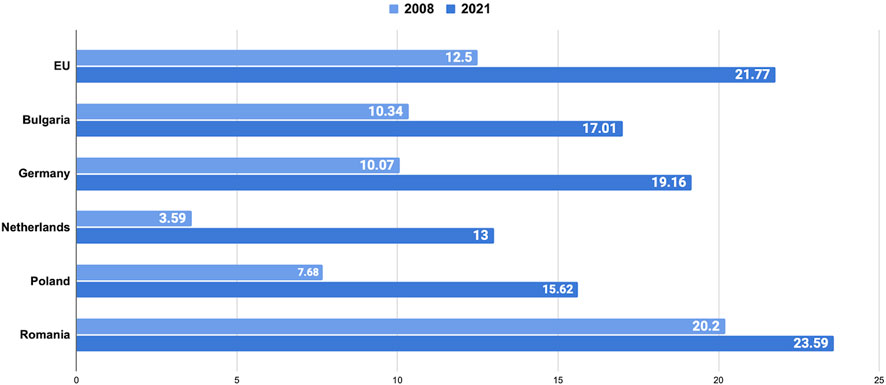
FIGURE 12. Share of energy from renewable sources. Source: Eurostat (2023).
The share of renewable energy used in agriculture and forestry, especially in the rural areas of EU countries, is the main focus of sustainable rural development. Figure 13 shows the share of energy from renewables and biofuels in 2010 and 2021 for selected countries in the EU. When examined between 2010 and 2021 in the EU, it is seen that the rate of renewable and biofuel in the energy used in agriculture and forestry increased from 7.5% to 11.4%. Although Germany showed a serious decrease in 2021 compared to 2010, it is in a better position with 21% compared to other countries and is 10 points above the EU average. The rate of renewable and biofuel in the energy used in agriculture and forestry in Bulgaria increased from 1.8% to 5.1%. Although Poland has a rate above the EU average, it did not show a significant change between 2010 and 2021. Netherlands have been growing steadily. Romania, on the other hand, has a fluctuating chart and the rate decreased from 1.7% in 2010 to 1.3% in 2021.
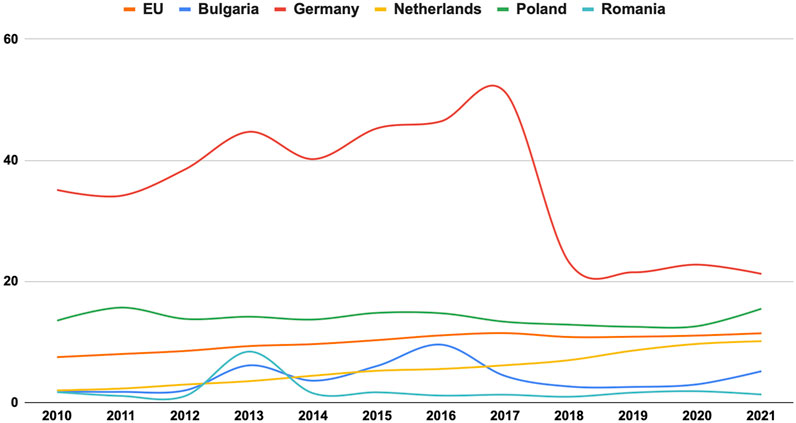
FIGURE 13. Share of energy from renewables and biofuels in agriculture and forestry. Source: Eurostat (2023).
5 Conclusion
The most fundamental point of sustainable rural development is the integration of all economic, environmental and social stakeholders. Achieving rural development in a socially balanced and sustainable way is one of the most important goals. Ensuring cooperation with local people and meeting their needs are also important requirements of rural development.
The EU has implemented many policies for rural development and tries to achieve the goals by determining the budget for financial support. In particular, the energy problem that arose after the outbreak of the Russian–Ukrainian war has caused the EU to take more serious decisions on energy and rural development. In order to achieve these goals, it is necessary to accurately identify the deficiencies and set the goals at an achievable and acceptable level. However, although this has been done successfully in some countries of the EU, it has not been done more decisively in others.
Germany and the Netherlands, examined in the study, have shown that they are close to achieving the future targets in all areas of sustainable rural development. However, Bulgaria, Poland and Romania, which are also examined in the study, need to take more serious steps in sustainable rural development. Although these countries are found to be doing well in some areas of rural development, sustainable rural development involves all stakeholders. For this reason, Bulgaria, Poland and Romania should act not in one area only, but also in the areas of environment, education, energy, economy, poverty and digitalization, taking into account all stakeholders in sustainable rural development. Therefore, the areas that Bulgaria, Poland and Romania, which have similar problems in rural areas, should focus on can be summarized as follows:
• In order the access and importance of education services in rural areas should be increased and the awareness of the society on this issue should be increased.
• In order to protect the environment, more importance should be given to natural resources, and the transition to renewable and sustainable resources should be realized faster.
• Incentives should be created to create employment that includes all stakeholders in rural areas and to prevent migration to the urban areas.
• Energy incentives and subsidies should be used in the right areas and their efficiency should be ensured.
• Competition incentives should be created in rural sectors, especially in agriculture and forestry.
• The society should be educated in digitalization, and preparations for the necessary infrastructure should be started.
Smart villages should be considered so that all stakeholders of rural development can benefit regionally, and sustainable resources can be created. Smart villages can enhance agricultural efficiency by implementing artificial intelligence, data analytics, and other related information technologies. Renewable energy sources and energy management systems can also amplify energy efficiency. Furthermore, access to digital resources and the internet can significantly elevate people’s knowledge and awareness on all matters. This proposal supports the adaptation of emerging technologies in rural areas, thereby fostering inclusive and new technology-based markets. Furthermore, it has a potential positive impact on environmental sustainability and climate change. Smart villages are therefore regarded as a comprehensive and consistent solution across economic, environmental, and socio-economic dimensions.
Data availability statement
The original contributions presented in the study are included in the article, further inquiries can be directed to the corresponding author.
Author contributions
UM: Writing–original draft, Writing–review and editing. DP: Writing–original draft, Writing–review and editing.
Funding
The author(s) declare that no financial support was received for the research, authorship, and/or publication of this article.
Conflict of interest
The authors declare that the research was conducted in the absence of any commercial or financial relationships that could be construed as a potential conflict of interest.
Publisher’s note
All claims expressed in this article are solely those of the authors and do not necessarily represent those of their affiliated organizations, or those of the publisher, the editors and the reviewers. Any product that may be evaluated in this article, or claim that may be made by its manufacturer, is not guaranteed or endorsed by the publisher.
Footnotes
1One of the major problems caused by migration from rural areas is the abandonment of agricultural land. This not only causes economic problems, but also has a negative impact on the environment. The sustainability of rural land management represents the ‘Life on Land’ goal, which is the 15th of the 17 Sustainable Development Goals adopted by the United Nations. One of the priorities of the ‘Life on Land’ goal is to create a world free of land degradation. Therefore, the abandonment of agricultural land is one of the major threats to sustainable land management, negatively affecting the quality of life, reducing agricultural incomes and increasing poverty. Sustainable land management should therefore be a key priority for the rural areas of the European Union (Pawlewicz and Pawlewicz, 2023).
2Depending on the degree of urbanization in a country, population shares differ by income group. Looking at the income groups defined by the World Bank in 2015, low-income countries have a low urban population share and a high rural population share. This difference is smaller in middle- and high-income countries, but there is still a difference in the type of urbanization. As a country’s level of development increases, it becomes more common and easier to move from rural to urban areas. This can also lead to growth in the labour market without increasing the population of urban areas. In high-income countries, it is more common for people living in cities to work in urban areas than in middle-income countries (OECD, 2020).
3According to Eurostat data, in the EU, the rural employment rate is 68.8% for women and 80.6% for men in 2022, showing the gender employment gap is about 12 percentage points. Also, the employment rate of cities (for people aged 20–64) is 70.7% for women and 79.4% for men, meaning that the gender employment gap in cities is about 9 percentage points.
4Due to intermittent data availability during the reporting period, EU averages are not included in the figure.
5The rural poverty rate is 8.9% in Malta and 11.2% in Czechia.
6Another notable study, conducted by Łuczak and Kalinowski in 2022, found that there was a serious improvement in poverty between 2010 and 2018, especially in Romania and Bulgaria.
7Analysis by Liu et al., in 2019 found that the primary driver of global emissions was rapid economic growth. For detailed information, see https://www.sciencedirect.com/science/article/abs/pii/S0048969719302165.
8Significant amounts of nitrous oxide and methane are among the GHG emissions from agricultural areas around the world and in the countries of the EU. For detailed information, see https://ourworldindata.org/emissions-by-sector.
9NACE (Nomenclature of Economic Activities) is the European statistical classification of economic activities.
References
Augère-Granier, M.-L. (2017). Rural poverty in the European union. Belgium: EPRS: European Parliamentary Research Service. Available at: https://policycommons.net/artifacts/1338363/rural-poverty-in-the-european-union/1946844/ (Accessed August 20, 2023).
Bagher, A. M., Vahid, M., Mohsen, M., and Parvin, D. (2015). Hydroelectric energy advantages and disadvantages. Am. J. Energy Sci. 2 (2), 17–20.
Costanza, J. K., Abt, R. C., McKerrow, A. J., and Collazo, J. A. (2017). Bioenergy production and forest landscape change in the southeastern United States. Gcb Bioenergy 9 (5), 924–939. gcbb.12386 [Accessed July 08, 2023]. doi:10.1111/gcbb.12386
Cremona, E. (2023). Fit for the future. not Fit-for-55 Available at: https://ember-climate.org/insights/research/fit-for-the-future-not-fit-for-55/ (Accessed August 09, 2023).
EEA (2022). European Environment Agency. Greenhouse gas emissions from agriculture in Europe. Available at: https://www.eea.europa.eu/ims/greenhouse-gas-emissions-from-agriculture (Accessed June 30, 2023).
Ernst, J., Dräger, S., Schmaus, S., Weymeirsch, J., Alsaloum, A., and Münnich, R. (2023). The influence of migration patterns on regional demographic development in Germany. Soc. Sci. 12 (5), 255. doi:10.3390/socsci12050255
European Commission (2019). Communication from the commission to the European parliament, the European council, the council, the European economic and social committee and the committee of the regions. The European Green Deal Available at: https://eur-lex.europa.eu/legal-content/EN/LSU/?uri=CELEX:52019DC0640 (Accessed March 03, 2023).
European Commission (2020). Country report. The Netherlands 2020. Available at: https://eur-lex.europa.eu/legal-content/EN/TXT/PDF/?uri=CELEX:52020SC0518 (Accessed June 06, 2023).
European Commission (2021). The EU’s 2021–2027 long-term budget and NextGenerationEU plan. Facts and figures. Available at: https://commission.europa.eu/strategy-and-policy/eu-budget/long-term-eu-budget/2021-2027_en (Accessed March 01, 2023).
European Commission (2022). Common agricultural policy 2023–2027. Available at: https://agriculture.ec.europa.eu/system/files/2022-12/csp-at-a-glance-eu-countries_en.pdf (Accessed March 01, 2023).
European Commission (2023a). Country report. Romania 2023. Available at: https://economy-finance.ec.europa.eu/system/files/2023-05/RO_SWD_2023_623_en.pdf (Accessed June 27, 2023).
European Commission (2023b). Rural development. Available at: https://ec.europa.eu/regional_policy/policy/themes/rural-development_en (Accessed February 12, 2023).
European Commission Digital Agenda (2023). Rural digital index. Digital Agenda data. Available at: https://digital-agenda-data.eu/charts/analyse-one-indicator-and-compare-countries (Accessed July 04, 2023).
Eurostat (2016). Rural development methodology. Available at: https://ec.europa.eu/eurostat/web/rural-development/methodology (Accessed September 03, 2023).
Eurostat (2018). Archive: statistics on rural areas in the EU. Available at: https://ec.europa.eu/eurostat/statistics-explained/index.php?title=Statistics_on_rural_areas_in_the_EU&oldid=391832#Digital_divide (Accessed June 21, 2023).
Eurostat (2021). Urban-rural Europe - introduction. Available at: https://ec.europa.eu/eurostat/statistics-explained/index.php?title=Urban-rural_Europe_-_introduction#Area_and_population (Accessed May 10, 2023).
Eurostat (2023). Data from: Eurostat database. Available at: https://ec.europa.eu/eurostat/databrowser/ (Accessed April 24, 2023).
GUS (2022). Rural areas in Poland in 2020. Statistics Poland. Available at: https://stat.gov.pl/en/topics/agriculture-forestry/agriculture/rural-areas-in-poland-2020,3,5.html (Accessed June 16, 2023).
IEA (2022). Is the European Union on track to meet its REPowerEU goals? Available at: https://www.iea.org/reports/is-the-european-union-on-track-to-meet-its-repowereu-goals (Accessed July 07, 2023).
IPCC (2019). Intergovernmental Panel on Climate Change. Climate change and land: an IPCC special report on climate change, desertification, land degradation, sustainable land management, food security, and greenhouse gas fluxes in terrestrial ecosystems. Geneva, Switzerland: IPCC. Available at: https://www.ipcc.ch/site/assets/uploads/2019/11/SRCCL-Full-Report-Compiled-191128.pdf (Accessed June 11, 2023).
Ivanov, B., and Sokolova, E. (2017). “The role of agriculture for income and employment in Bulgarian rural areas,” in Proceeding of the international scientific conference strategies for the agri-food sector and rural areas-dilemmas of development. Available at: https://ageconsearch.umn.edu/record/302751/files/pw_52_1.pdf#page=211 (Accessed June 22, 2023).
Jończy, R., Śleszyński, P., Dolińska, A., Ptak, M., Rokitowska-Malcher, J., and Rokita-Poskart, D. (2021). Environmental and economic factors of migration from urban to rural areas: evidence from Poland. Energies 14 (24), 8467. doi:10.3390/en14248467
Liu, D., Guo, X., and Xiao, B. (2019). What causes growth of global greenhouse gas emissions? Evidence from 40 countries. Sci. Total Environ. 661, 750–766. doi:10.1016/j.scitotenv.2019.01.197
Łuczak, A., and Kalinowski, S. (2022). A multidimensional comparative analysis of poverty statuses in European Union countries. Int. J. Econ. Sci. 11 (1), 146–160. doi:10.52950/es.2022.11.1.009
Maradin, D. (2021). Advantages and disadvantages of renewable energy sources utilization. Int. J. Energy Econ. Policy 11, 176–183. doi:10.32479/ijeep.11027
Maucorps, A., Römisch, R., Schwab, T., and Vujanović, N. (2023). The impact of the green and digital transition on regional cohesion in Europe. Intereconomics 2023 (2), 102–110. doi:10.2478/ie-2023-0021
OECD (1994). “Territorial indicators of employment,” in Focusing on rural development (Paris: OECD). https://d-nb.info/949939498/04 (Accessed August 22, 2023).
OECD (2012). “Linking renewable energy to rural development,” in OECD green growth studies. linkingrenewableenergytoruraldevelopment.htm.
OECD European Commission (2020). Cities in the world. A new perspective on urbanisation. Available at: https://www.oecd-ilibrary.org/docserver/d0efcbda-en.pdf?expires=1688916592&id=id&accname=guest&checksum=8EE98CB924CF933C9561AB280E81CDD3 (Accessed May 20, 2023).
Our World in Data (2023). Research and data to make progress against the world’s largest problems. Available at: https://ourworldindata.org/ (Accessed March 22, 2023).
Pawlewicz, A., and Pawlewicz, K. (2023). The risk of agricultural land abandonment as a socioeconomic challenge for the development of agriculture in the European Union. Sustainability 15 (4), 3233. doi:10.3390/su15043233
Petrov, K. (2021). The regional development of the rural areas in Bulgaria and the support of the European Union. Eur. Countrys. 13 (1), 208–221. doi:10.2478/euco-2021-0012
Popescu, A. (2022). Income inequality in the countries of the European Union. Manag. Econ. Eng. Agric. Rural Dev. 22 (3), 547–560.
REPowerEU Plan (2022). Implementıng the Repower EU Action Plan: investment needs, hydrogen accelerator and achieving the bio-methane targets. Available at: https://eur-lex.europa.eu/legal-content/EN/TXT/PDF/?uri=CELEX:52022SC0230&from=E (Accessed March 05, 2023).
Richter, B. D., Postel, S., Revenga, C., Scudder, T., Lehner, B., Churchill, A., et al. (2010). Lost in development’s shadow: the downstream human consequences of dams. Water Altern. 3 (2), 14.
UNFCCC (2015). Adoption of the Paris agreement. UN climate change. Available at: https://unfccc.int/documents/9097 (Accessed May 22, 2023).
Upreti, B. R. (2004). Conflict over biomass energy development in the United Kingdom: some observations and lessons from England and Wales. Energy Policy 32 (6), 785–800. doi:10.1016/s0301-4215(02)00342-7
US Department of Agriculture Economic Research Service (2019). What is Rural? Available at: https://www.ers.usda.gov/topics/rural-economy-population/rural-classifications/what-is-rural/ (Accessed September 10, 2023).
WCED (1987). Report of the world commission on environment and development: Our common future. Available at: https://sustainabledevelopment.un.org/content/documents/5987our-common-future.pdf (Accessed March 10, 2023).
Wolsink, M. (2010). Near-shore wind power: protected seascapes, environmentalists’ attitudes, and the technocratic planning perspective. Land Use Policy 27 (2), 195–203. doi:10.1016/j.landusepol.2009.04.004
Keywords: sustainable rural development, rural areas, European Union, renewable energy, digitization, smart villages, economic impact
Citation: Memo U and Pieńkowski D (2023) Sustainable rural development indicators in Bulgaria, Germany, Poland, Romania and the Netherlands: a review of data. Front. Environ. Sci. 11:1323688. doi: 10.3389/fenvs.2023.1323688
Received: 18 October 2023; Accepted: 14 November 2023;
Published: 28 November 2023.
Edited by:
Sławomir Kalinowski, Polish Academy of Sciences, PolandReviewed by:
Barbara Magdalena Wieliczko, Polish Academy of Sciences, PolandJan Žukovskis, Vytautas Magnus University, Lithuania
Copyright © 2023 Memo and Pieńkowski. This is an open-access article distributed under the terms of the Creative Commons Attribution License (CC BY). The use, distribution or reproduction in other forums is permitted, provided the original author(s) and the copyright owner(s) are credited and that the original publication in this journal is cited, in accordance with accepted academic practice. No use, distribution or reproduction is permitted which does not comply with these terms.
*Correspondence: Umutcan Memo, dW11dGNhbi5tZW1vQHVwLnBvem5hbi5wbA==
 Umutcan Memo
Umutcan Memo Dariusz Pieńkowski
Dariusz Pieńkowski